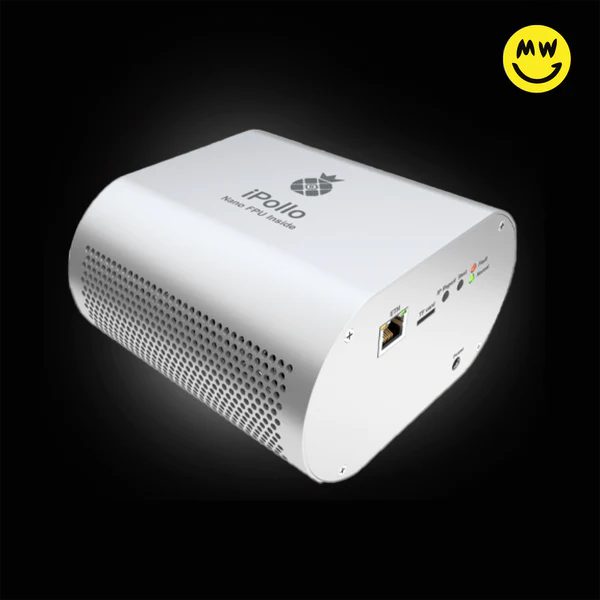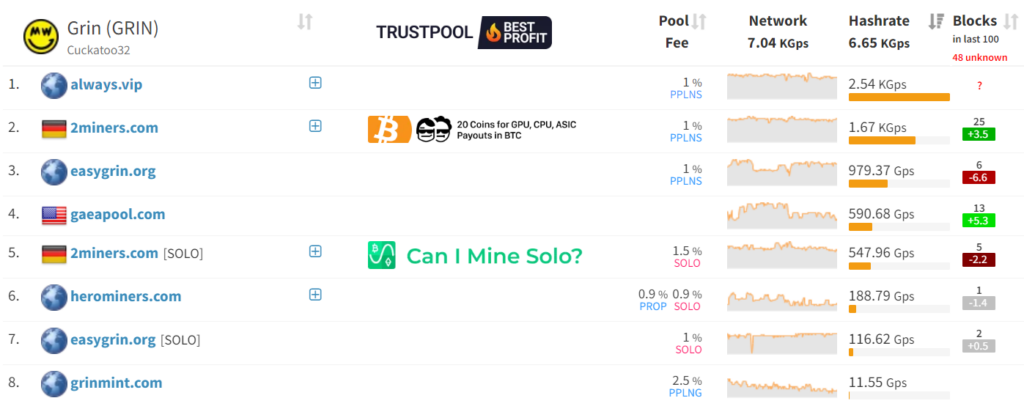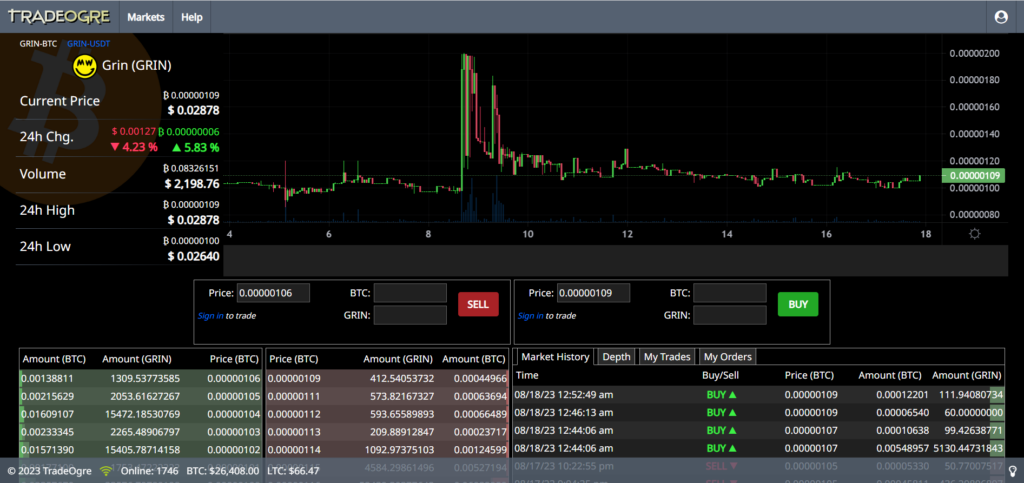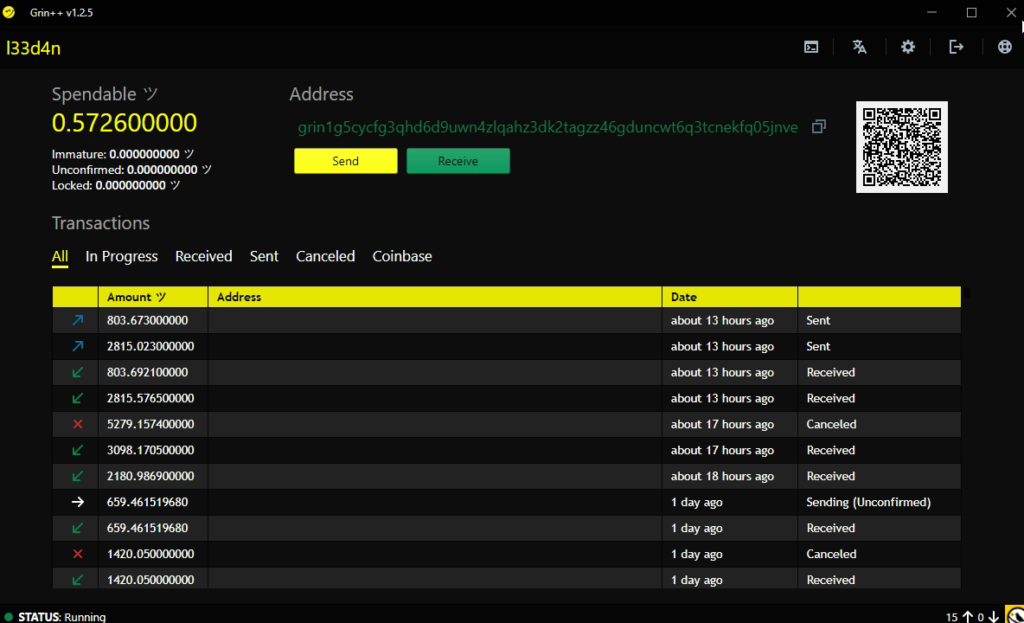Grin Coin, a relatively new entrant in the cryptocurrency market, has quickly gained attention for its unique approach to privacy and scalability. Built on the Mimblewimble protocol, Grin Coin offers confidential transactions and a reduced blockchain size, making it a promising option for users seeking privacy and efficiency. In this article, we’ll explore the key features of Grin Coin, its use cases, and what the future holds for this intriguing cryptocurrency.
Key Takeaways
- Innovative Privacy Features: Grin’s use of the Mimblewimble protocol offers enhanced privacy through confidential transactions and CoinJoin, making it a top choice for privacy-focused transactions.
- Scalability: Grin addresses scalability issues through the Mimblewimble protocol’s transaction aggregation, allowing it to handle a higher volume of transactions efficiently.
- Community-Driven Development: Grin’s open-source, community-driven development approach aligns with its philosophy of being a fair and accessible cryptocurrency for everyone.
- Unique Tokenomics: Grin’s linear emission rate and lack of a maximum supply cap encourage long-term use and adoption, setting it apart from other cryptocurrencies.
- Growing Adoption: Grin Coin’s growing adoption is driven by its unique features, such as privacy and scalability, making it an attractive option for various use cases.
Table of Contents
History of Grin Coin

Grin Coin was launched in January 2019 as an open-source cryptocurrency project. It was developed by a group of anonymous developers who were inspired by the Mimblewimble whitepaper released in 2016. Since its inception, Grin has attracted a growing community of developers and users, thanks to its focus on privacy, scalability, and decentralization.
Technical Overview
Grin Coin’s technical foundation is built on the Mimblewimble protocol, a revolutionary approach to blockchain privacy and scalability. This protocol, named after a spell from the Harry Potter series, was introduced in a whitepaper by an anonymous author using the pseudonym “Tom Elvis Jedusor” in 2016. Grin is one of the first cryptocurrencies to implement this protocol, and its technical features set it apart from other cryptocurrencies.
Mimblewimble Protocol
The Mimblewimble protocol is designed to enhance both privacy and scalability in blockchain transactions. It achieves this through two main features: confidential transactions and transaction aggregation.
Confidential Transactions
Confidential transactions are a key feature of the Mimblewimble protocol. Unlike traditional blockchain transactions, where the transaction amounts are publicly visible, confidential transactions hide the amounts involved. This is achieved using a cryptographic technique called “Pedersen Commitments,” which allows the amounts to be encrypted in a way that still allows for the verification of transactions. Only the sender and receiver of a transaction can view the actual amounts involved.
Transaction Aggregation
Transaction aggregation is another crucial feature of the Mimblewimble protocol that enhances scalability. In a typical blockchain, each transaction is recorded separately, leading to a large and ever-growing blockchain size. Mimblewimble addresses this issue by aggregating multiple transactions into a single block. This reduces the overall size of the blockchain and improves efficiency.
Grin Coin Tokenomics
Tokenomics, also known as token economics, refers to the economic model that governs a cryptocurrency’s issuance, distribution, and utility. Grin’s tokenomics are unique and differ from many other cryptocurrencies. Let’s explore the key aspects of Grin’s tokenomics.
Emission Rate
Grin has a linear emission rate, meaning that a fixed amount of Grin is created with each new block. Specifically, Grin has an emission rate of 60 Grin per block, with a new block being mined approximately every minute (so one Grin per second). This linear emission rate is a departure from the halving model used by cryptocurrencies like Bitcoin, where the block reward is halved every four years.
No Maximum Supply Cap
Unlike many cryptocurrencies that have a maximum supply cap, Grin Coin does not have a cap on its total supply. The linear emission rate means that Grin Coin’s supply will continue to increase indefinitely. This approach is intended to encourage long-term use and adoption of Grin Coin, as there is no fixed limit on the total supply.
Inflation Rate
Grin’s inflation rate decreases over time due to its linear emission rate. In the early years of Grin, the inflation rate is relatively high, as the newly minted coins represent a significant percentage of the total supply. However, as the total supply of Grin increases, the newly minted coins represent a smaller percentage of the total supply, leading to a decreasing inflation rate.
Monetary Policy
Grin Coin’s monetary policy is designed to encourage long-term use and adoption. The linear emission rate and lack of a maximum supply cap are intended to create a stable and predictable monetary policy. Grin’s developers believe that this approach will encourage users to spend and use Grin, rather than hoarding it in anticipation of future price increases.
Grin Coin’s Unique Features

Grin’s unique features stem from its implementation of the Mimblewimble protocol, which offers several advantages over traditional blockchain designs. These features make Grin Coin stand out in the crowded cryptocurrency market and contribute to its growing popularity.
Privacy Features
Grin Coin’s primary focus is on privacy, and it achieves this through several mechanisms:
Confidential Transactions
As mentioned earlier, Grin uses confidential transactions to hide the amounts involved in transactions. This is achieved through cryptographic techniques that allow the amounts to be encrypted while still enabling transaction verification. Only the sender and receiver can view the actual transaction amounts, ensuring privacy.
CoinJoin
Grin also uses a technique called CoinJoin, which further enhances privacy. CoinJoin is a method of combining multiple transactions into a single transaction, making it difficult to trace individual transactions. This adds an additional layer of privacy to Grin transactions.
Dandelion Relay
Grin Coin uses the Dandelion Relay to improve transaction privacy. This technique involves randomly routing transactions through several nodes before broadcasting them to the network. This makes it harder to trace the origin of a transaction, further enhancing privacy.
Scalability
Grin’s design also addresses the scalability issues faced by many blockchains. Scalability is crucial for the long-term success of any cryptocurrency, as it determines how well the network can handle a large number of transactions.
Transaction Aggregation
As mentioned earlier, Grin uses transaction aggregation to reduce the size of the blockchain. By aggregating multiple transactions into a single block, Grin Coin can handle more transactions with less data, improving efficiency.
Pruning
Grin Coin also uses a technique called pruning to reduce the size of the blockchain. Pruning involves removing old, unnecessary data from the blockchain, making it more compact and efficient. This further enhances Grin’s scalability.
Decentralization and Community-Driven Development
Grin Coin is committed to decentralization and community-driven development. The project is open-source, and its development is driven by a community of volunteers. There is no pre-mine or initial coin offering (ICO) for Grin, and the project does not have a central governing body. This approach aligns with Grin’s philosophy of being a fair and accessible cryptocurrency for everyone.
How to Acquire Grin Coin
Acquiring Grin Coin is a straightforward process, and there are several methods available. Whether you’re interested in mining, purchasing, or earning Grin, we’ve got you covered.
Mining Grin Coin
Mining is one of the primary methods of acquiring Grin. Grin initially used the Cuckatoo31+ proof-of-work algorithm, which was designed to be ASIC-resistant. However, as the network has evolved, ASIC miners have been developed for Grin, making it more efficient to mine.
ASIC Mining
Application-Specific Integrated Circuit (ASIC) miners are specialized hardware devices designed for mining specific cryptocurrencies. ASIC miners are more powerful and efficient than consumer-grade hardware, such as GPUs. For Grin, ASIC miners like the iPollo G1 Mini have been developed, offering high performance and efficiency for Grin Coin mining.
iPollo G1 Mini

The iPollo G1 Mini is a popular ASIC miner for Grin. It offers a hash rate of 1.2 GPS (graphs per second) and consumes only 120W of power, making it an energy-efficient option for Grin mining. The iPollo G1 Mini is compact and easy to set up, making it a suitable choice for both beginners and experienced miners.
Mining Process
The mining process involves solving complex mathematical problems to validate transactions and secure the network. Miners are rewarded with newly minted Grin Coins for their efforts. To start mining Grin, you’ll need an ASIC miner like the iPollo G1 Mini, a stable internet connection, and a Grin wallet to receive your rewards.
Mining Pools

Joining a mining pool is a popular option for Grin miners. In a mining pool, multiple miners combine their computational power to solve blocks more quickly. The rewards are then distributed among the participants based on their contribution. Joining a mining pool can increase the frequency of your mining rewards, making it a more stable option compared to solo mining.
Purchasing Grin Coin
Another way to acquire Grinis by purchasing it on a cryptocurrency exchange. While there are several exchanges that list Grin Coin, it’s essential to choose a reputable and reliable platform.
TradeOgre Exchange

TradeOgre is a cryptocurrency exchange that has become popular among Grin Coin enthusiasts. It’s known for its oldschool interface and reliable service. TradeOgre is currently the only exchange that supports 100% working Grin withdrawals using the Slatepack method.
Slatepack Method
The Slatepack method is a new standard for Grin transactions. It simplifies the process of sending and receiving Grin by using a single string of characters, known as a Slatepack address. This address can be used for both sending and receiving Grin, making it a convenient option for users. When withdrawing Grin from TradeOgre, you can use your Slatepack address to receive your funds directly to your Grin wallet.
Earning Grin
In addition to mining and purchasing, you can also earn Grin Coin by providing services or selling goods. Several platforms and businesses accept Grin Coin as a form of payment. By offering your products or services in exchange for Grin Coin, you can earn cryptocurrency without having to invest in mining equipment or purchase it on an exchange.
Grin Coin Wallets
A Grin wallet is a software application that allows you to store, send, and receive Grin Coin. It’s essential to choose a secure and user-friendly wallet to manage your Grin holdings. There are several types of wallets available for Grin, each with its own features and benefits.
Desktop Wallets

Desktop wallets are software applications that you can download and install on your computer. They offer a user-friendly interface and are suitable for both beginners and experienced users. Desktop wallets provide a high level of security, as your private keys are stored on your computer and not on a third-party server.
Grin++
Grin++ is a popular desktop wallet for Grin. It offers a user-friendly interface and supports the Slatepack method for transactions. Grin++ is available for Windows, macOS, and Linux.
Niffler
Niffler is a Grin GUI node and wallet that offers a user-friendly interface for managing Grin. It supports the Slatepack method for transactions and provides an easy-to-use platform for both beginners and experienced users. Niffler is available for Windows, Linux, and macOS.
Mobile Wallets
Mobile wallets are apps that you can download and install on your smartphone. They offer the convenience of managing your Grin holdings on the go. Mobile wallets are suitable for everyday transactions and are easy to use.
Ironbelly
Ironbelly offers a user-friendly interface and supports the Slatepack method for transactions. It is available for iOS and Android.
Use Cases and Adoption
Grin’s unique features, such as privacy and scalability, make it an attractive option for various use cases. As Grin continues to evolve, its adoption is expected to grow across different sectors and industries.
Online Payments
Grin’s privacy features make it an ideal choice for online payments. With confidential transactions and CoinJoin, Grin offers a high level of privacy, making it suitable for users who prefer to keep their financial transactions private. Several online merchants and platforms accept Grin as a form of payment, and its adoption in the e-commerce sector is expected to grow.
Remittances
Grin Coin’s scalability and low transaction fees make it a viable option for remittances. Sending money across borders can be expensive and time-consuming with traditional banking systems. Grin offers a faster and more cost-effective alternative for remittances, making it an attractive option for users looking to send money internationally.
Privacy-Focused Transactions
Grin Coin’s focus on privacy makes it a suitable choice for users seeking privacy-focused transactions. Whether it’s for personal or business reasons, Grin offers a high level of privacy for financial transactions. Its use of the Mimblewimble protocol, confidential transactions, and CoinJoin ensures that transaction details are kept private, making it an attractive option for users concerned about their financial privacy.
Micropayments
Grin’s low transaction fees and scalability make it an ideal choice for micropayments. Micropayments are small financial transactions, often less than a dollar, that are typically not feasible with traditional payment methods due to high transaction fees. Grin Coin offers a cost-effective solution for micropayments, making it suitable for applications such as online tipping, content monetization, and pay-per-use services.
Adoption Trends
Grin’s adoption has been growing steadily since its launch in 2019. Its unique features and focus on privacy and scalability have attracted a growing community of users and developers. Several online merchants, platforms, and services accept Grin as a form of payment, and its adoption is expected to continue growing in the coming years.
Challenges and Criticisms
Grin, like any other cryptocurrency, faces its share of challenges and criticisms. While it has garnered a dedicated following and has unique features that set it apart from other cryptocurrencies, it is essential to consider the potential hurdles and concerns associated with Grin Coin.
Regulatory Concerns
Grin Coin’s focus on privacy has raised regulatory concerns. Many governments and regulatory bodies are wary of privacy coins, as they can be used for illicit activities due to their ability to hide transaction details. Grin, with its confidential transactions and CoinJoin features, may face regulatory scrutiny and potential restrictions in some jurisdictions.
Competition
Grin faces competition from other privacy coins, such as Monero, Zcash, and Dash. These cryptocurrencies have been around longer and have established a larger user base. Grin Coin’s unique features and focus on scalability may set it apart, but it still needs to compete with these well-established privacy coins for adoption and market share.
Technological Hurdles
Grin Coin’s implementation of the Mimblewimble protocol is innovative, but it also comes with technological hurdles. The protocol is relatively new, and its long-term viability and security are still being tested. Grin Coin’s developers need to address potential vulnerabilities and ensure the network’s security and stability as it continues to grow.
Community-Driven Development
Grin Coin’s community-driven development is both a strength and a challenge. While it aligns with the project’s philosophy of decentralization, it also means that Grin relies on volunteers for its development. This approach can lead to slower development progress and potential disagreements within the community regarding the project’s direction.
Monetary Policy Criticisms
Grin’s linear emission rate and lack of a maximum supply cap have been criticized by some in the cryptocurrency community. Critics argue that this monetary policy could lead to inflation and devalue the currency over time. Grin Coin’s developers believe that the linear emission rate encourages long-term use and adoption, but it remains a point of contention.
Grin Coin Foundation
The Grin Foundation is an organization that supports the development and growth of Grin. The foundation plays a crucial role in the Grin Coin ecosystem by funding development efforts, promoting community engagement, and ensuring the project’s long-term sustainability.
Role of the Grin Foundation
The Grin Foundation’s primary role is to support the Grin Coin project and its community. The foundation achieves this by:
Funding Development
The Grin Foundation funds development efforts, including software updates, improvements, and bug fixes. This ensures that Grin Coin continues to evolve and stay up-to-date with the latest technological advancements.
Promoting Community Engagement
The Grin Foundation promotes community engagement by organizing events, discussions, and initiatives. This fosters a sense of community and encourages active participation from Grin Coin users and developers.
Ensuring Long-Term Sustainability
The Grin Foundation plays a crucial role in ensuring the project’s long-term sustainability. By managing funds, supporting development efforts, and promoting community engagement, the foundation helps ensure that Grin Coin continues to thrive in the long run.
Funding Sources
The Grin Foundation relies on donations to fund its activities. The foundation has received several significant donations, including anonymous Bitcoin donations from very old wallets. These donations have sparked rumors that they could belong to Satoshi Nakamoto, the pseudonymous creator of Bitcoin.
Anonymous Bitcoin Donations
In November 2019, the Grin Foundation received an anonymous donation of 50 BTC from a very old Bitcoin wallet. The age of the wallet and the size of the donation sparked rumors that it could belong to Satoshi Nakamoto. While there is no concrete evidence to confirm these rumors, the donation was a significant boost for the Grin Coin Foundation and its efforts to support the Grin Coin project.
Future Prospects
Grin Coin’s potential for growth is evident in its unique features and growing adoption. As the cryptocurrency market continues to evolve, Grin Coin’s focus on privacy, scalability, and decentralization positions it as a promising player in the industry. Let’s explore some of the future prospects for Grin.
Continued Development and Updates
Grin Coin’s development team and community are actively working on improving the cryptocurrency. The project’s open-source nature and community-driven development mean that it can benefit from contributions from developers worldwide. As Grin continues to receive updates and improvements, it is likely to become more secure, efficient, and user-friendly.
Growing Adoption
Grin Coin’s adoption has been steadily increasing since its launch in 2019. As more users recognize its benefits, Grin Coin’s adoption is expected to grow across various sectors and industries. Online merchants, platforms, and services that value privacy and scalability are likely to adopt Grin Coin as a form of payment.
Regulatory Developments
As mentioned earlier, Grin Coin’s focus on privacy has raised regulatory concerns. However, the regulatory landscape for cryptocurrencies is continually evolving. As governments and regulatory bodies gain a better understanding of privacy coins and their potential benefits, there may be more clarity and acceptance of Grin and other privacy-focused cryptocurrencies.
Technological Advancements
Grin’s implementation of the Mimblewimble protocol is innovative and sets it apart from other cryptocurrencies. As the protocol continues to be tested and refined, Grin Coin may benefit from technological advancements that further enhance its privacy and scalability features.
Community Growth
Grin Coin’s community-driven development and open-source nature have attracted a dedicated following. As the community continues to grow, Grin Coin is likely to benefit from increased contributions, development efforts, and user engagement. A strong and active community is essential for the long-term success of any cryptocurrency.
Conclusion
Grin Coin’s focus on privacy, scalability, and decentralization sets it apart from other cryptocurrencies. Its use of the Mimblewimble protocol and unique features make it a promising option for users seeking a privacy-focused cryptocurrency. As Grin Coin continues to evolve and gain adoption, it’s a cryptocurrency to watch in the coming years.
FAQs
Where to buy Grin Coin?
You can buy Grin Coin on cryptocurrency exchanges such as TradeOgre. In the USA, TradeOgre is a popular option where you can purchase Grin Coin using Bitcoin (BTC).
How to receive Grin Coin?
To receive Grin Coin, you need a Grin Coin wallet that supports the Slatepack method for transactions. You can provide your Slatepack address to the sender, who will use it to send Grin Coin to your wallet.
Where to store Grin Coin for US citizens?
For US citizens, the Grin++ wallet is a recommended option for storing Grin Coin. It’s a desktop wallet available for Windows, macOS, and Linux, and it supports the Slatepack method for transactions.
Where to buy Grin Coin in the USA?
In the USA, you can buy Grin Coin on TradeOgre.com (no KYC) using Bitcoin (BTC).
How to mine Grin Coin?
To mine Grin Coin, you can purchase an iPollo ASIC miner, such as the iPollo G1 Mini. Once you have the ASIC miner, you can mine Grin Coin on the Grinmint community pool.


